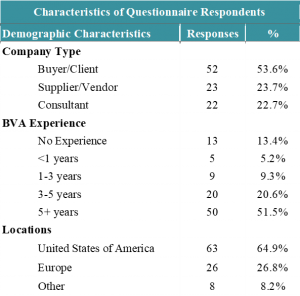
17 Mar Why Do Companies Stop Using the Best Value Approach?
Despite the countless successes of the Best Value Approach, practitioners are finding it hard to implement and sustain the BVA in organizations. The BVA is founded on simple and easy principles, so why is it difficult to sustain in organizations?
The Challenge of BVA
In our last article, we highlighted some of the major struggles that organizations have in sustaining the BVA. Some of the struggles were that a BVA expert leaves an organization, change in upper management, and internal politics. This research took the viewpoint of an organization. It looked at the BVA effort in macro view but did not take into account the viewpoint of the practitioners. In this article, I wanted to research the problem from a more granular level. I wanted to take the practitioner perspective on issues and problems with the implementation and sustainability of BVA to see if it matched the organizational perspective. In order to do this, I needed the feedback from BVA Experts in the industry that understood BVA and had extensive experience using it.
Surveying BVA Experts
 A survey was conducted with BVA practitioners on the issue of sustaining and implementing the BVA. The survey targeted practitioners that had experience or had been educated in using the BVA. The survey was sent out to 234 BVA practitioners, and 97 practitioners filled out the survey and provided their feedback on some free response questions as well as rating BVA factors.
A survey was conducted with BVA practitioners on the issue of sustaining and implementing the BVA. The survey targeted practitioners that had experience or had been educated in using the BVA. The survey was sent out to 234 BVA practitioners, and 97 practitioners filled out the survey and provided their feedback on some free response questions as well as rating BVA factors.
The characteristics of the respondents are shown in Table 1. The following is significant about the table:
- 70%+ of respondents had 3+ years of experience in using BVA.
- 50% of the respondents were from the client side.
- The majority of respondents were from USA and Europe.
We analyzed the responses of all the practitioners and separated the results into two sections:
- Major issues in implementing BVA
- BVA Problem Factors
Major Issues in Implementing BVA
From the free response questions, the researcher identified 94 keywords and grouped these responses into six key themes show below (the percentages indicate how many respondents agree):
- Client Management (72%)
- Traditional Culture (62%)
- Absence of Visionaries (30%)
- The BVA (24%)
- The Vendor (19%)
- The Projects (8%)
From the results of this section, you can see that from a practitioner perspective that there are some disagreements about what is causing the issues with BVA. Regardless, most practitioners would agree that client management and traditional culture are the main barriers in implementing and sustaining the BVA.
BVA Problem Factors
 In the problem factor section, survey respondents were given 16 BVA success factors to rate on a Likert scale. The scale ranged from strongly disagree to strongly agree as to whether they thought the factor made BVA difficult to implement and sustain. Out of the 16 factors, 64% respondents agreed that 6 of them caused major issues:
In the problem factor section, survey respondents were given 16 BVA success factors to rate on a Likert scale. The scale ranged from strongly disagree to strongly agree as to whether they thought the factor made BVA difficult to implement and sustain. Out of the 16 factors, 64% respondents agreed that 6 of them caused major issues:
- Minimizing stakeholder Involvement
- Minimizing of communication and collaboration
- Minimizing client management, direction, and control of Vendors
- Supplier creating the scope of project
- Minimizing contract importance
- Having senior/top management support
All of these factors are considered components of “client management”. The research defined “client management” as a comprehensive word to describe the interactions of the client/buyer in dealing with the project and vendor. This included how the client solicited the project, how the client treated the vendors, and the way in which clients made decision on the projects.
The results suggests that client management is the only issue that the majority of survey respondents agree on. This is an interesting finding considering that 50% of the respondents were from the client side. The research also investigated to see if there were any correlations with the characteristics of the respondents. The results found a high-level agreement (70% or higher) in their responses regardless of job title, position or experience. It appears that all the respondents were on the same page.
Conclusion:
The results of the survey clearly show that most practitioners believe that client management is the biggest barrier in implementing and sustaining the BVA. Although this isn’t a new revelation to the BVA, it confirms the reality of our current situation. The BVA needs to adapt in order to make it easier for clients to accept the approach. The voices of the practitioners have been heard and the latest updates for the BVA all deal with making it easier for client to implement and sustain the approach. With the newest adjustments, we believe that more organizations will be able to implement and sustain the approach that ever before.
In our next article, we will share new strategies that BVA practitioners are using to make client involvement easier. If you would like more information contact joseph.kashiwagi@skema.edu


